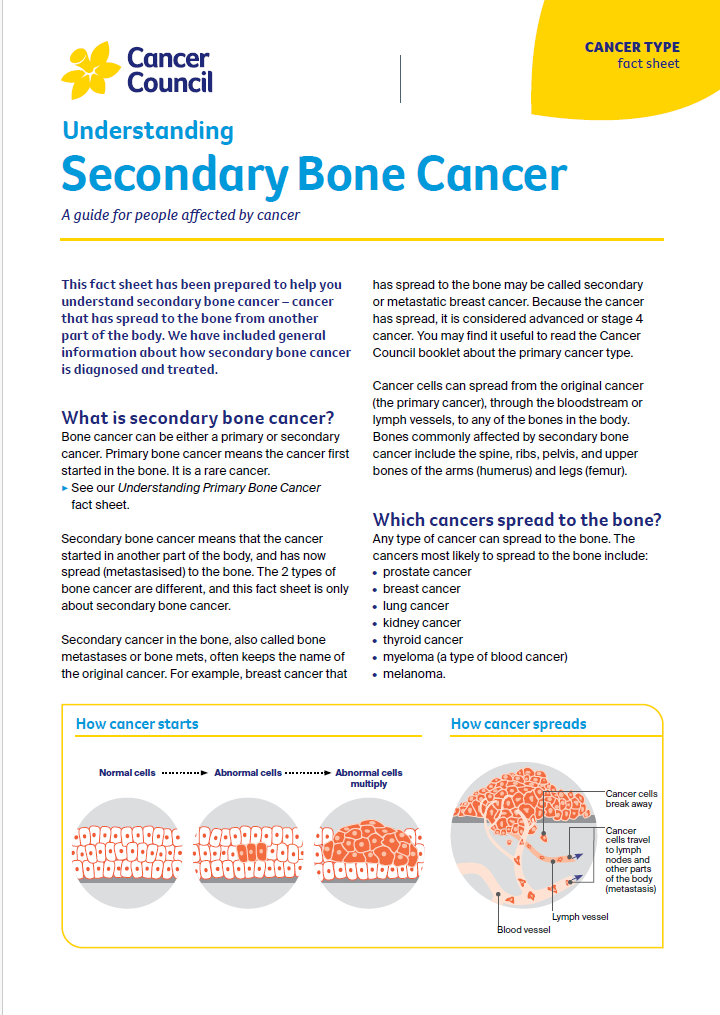- Home
- Secondary bone cancer
- Diagnosis
Diagnosis of secondary bone cancer
Secondary bone cancer may be found at the same time as the primary cancer, or months or years after the primary cancer has been treated.
In some cases, secondary bone cancer is diagnosed before the primary cancer is found and, sometimes, the primary cancer can’t be found.
When tests can’t find where the cancer started, this is known as cancer of unknown primary (CUP).
Learn more about:
Tests
If your doctor is concerned the cancer has spread to the bones, you may have some tests, including a:
| blood tests | Usually a full blood count, a check of your calcium levels and possibly a specific blood test called an alkaline phosphatase (ALP) test. |
| bone x-ray | A scan to show bone damage, fractures or creation of new bone. |
| bone scan | A small amount of radioactive dye is injected into a vein; it collects in the bone and any abnormal changes are found by a special camera and computer. |
| CT or MRI scans | CT (computerised tomography) and MRI (magnetic resonance imaging) scans create detailed cross-sectional pictures to highlight any bone abnormality; they take between 30 and 60 minutes. |
| PET–CT scan | This is a PET (positron emission tomography) scan combined with a CT scan, which provides more detailed information than a CT on its own; you are injected with a small amount of radioactive glucose solution, which will highlight any cancerous areas on the scan. |
| bone biopsy | Removal of some cells and tissue from the affected bone for examination under a microscope. The biopsy may be done in one of two ways. In a core needle biopsy, local anaesthetic numbs the area, then a thin needle is inserted to remove a sample of bone. In a surgical biopsy, a surgeon removes a small section of bone under general anaesthetic. The sample is sent to a pathologist who checks it for cancer cells. |
Prognosis
Prognosis means the expected outcome of a disease. Factors affecting prognosis include whether the cancer has spread to other parts of your body, the type of primary cancer, how quickly it is growing and its response to treatment.
It is not possible for anyone to predict the exact course of the disease, but your doctor can provide you with general information on the expected outcomes of people in a similar situation to you and discuss treatment options. The expected outcome also depends on the site that the cancer started from (i.e. the prognosis of the primary cancer).
Secondary bone cancer can’t always be cured, but treatment can reduce symptoms and improve quality of life. In some cases, treatment can keep secondary bone cancer under control for many years.
→ READ MORE: Treatment of secondary bone cancer
We learn a lot more about our body and about life than a lot of people ever learn.
Margaret
Podcast for people affected by advanced cancer
Listen now
More resources
Prof Angela Hong, Radiation Oncologist, Chris O’Brien Lifehouse, and Clinical Professor, The University of Sydney, NSW; Anne Booms, Nurse Practitioner Supportive and Palliative Care, Icon Cancer Centre Midlands, WA; A/Prof Richard Boyle, Orthopaedic Surgeon, Royal Prince Alfred Hospital Sydney, NSW; Belinda Fowlie, Bone Tumour Nurse Practitioner Candidate, SA Bone and Soft Tissue Tumour Unit, Flinders Medical Centre, SA; Dr Tahlia Scheinberg, Medical Oncologist, Chris O’Brien Lifehouse, NSW; Dr Clare Zachulski, Palliative Care Specialist, Westmead Hospital, NSW.
View the Cancer Council NSW editorial policy.
View all publications or call 13 11 20 for free printed copies.

